Supply and Demand
An in-depth analysis shows Caspian oil's potential
Whether one talks about exploration, field projects or pipeline construction, the Caspian Sea region is destined to influence global energy and geopolitics for years to come
Randall Collum Jr., Adrian J. Gregorek, Amit Sondhi and Michael J. Economides, University of Houston
As new sources of hydrocarbons, particularly from non-OPEC countries, be-come increasingly important to the world, the Caspian Sea region has the potential to become one of the major oil- and gas-producing areas. The region is thought to hold the world's third-largest oil and gas reserves behind the Middle East and Russia.
New oil discoveries in the northern Caspian Sea have underlined the region's importance. Kashagan field, off the northern shore of the Caspian Sea, is expected to be the second-largest petroleum deposit in the world, following Saudi Arabia's Ghawar field. It is the largest new oil field found over the last 30 years. By 2010, the Caspian region is expected to produce 3 million bopd, doubling current output of about 1.5 million bopd.
Most of the Caspian discoveries are in Kazakhstan, although by 2010 a significant amount of oil should come from Azerbaijan, predicted to account for almost one-third of the region.
In December 2003, Kazakhstan President Nursultan Nazarbaev stated, “Global experts consider the nervousness of Arab countries and all of OPEC's (members) comes not only from the massiveness of the Caspian reserves, but also because the region's states do not enter OPEC.” He further suggested that the countries surrounding the Caspian should create an OPEC-like oil cartel, to support oil prices and reassure OPEC, itself.
Until recently, Russia controlled oil exports from the area, with the main export pipelines for Caspian oil passing through its territory. The US government supports alternative routes that bypass Russia, which is not pleased that the new pipelines will give the West access to Caspian oil and gas, without Russian control.
The geopolitics associated with the region have been a major influence on the Caspian petroleum industry. The US has blatantly thrown its clout be-hind the American petroleum companies involved.
Transportation of Caspian oil and gas does not only involve Russia. Conflicts over land ownership and the US' bad relationship with Iran have played important roles in establishing potential pipeline routes. Also, the division of reserves located in the Caspian Sea has been an ongoing dispute, with Iran and Turkmenistan in disagreement with Kazakhstan, Azerbaijan and Russia on how the Caspian Sea should be divided.
An example of hostility that surrounds this issue is what happened to BP in 2001. While a BP research vessel was in a presumably Azerbaijani sector of the Caspian Sea disputed by Iran, an Iranian gunboat chased it out of those waters. This event prompted BP to suspend its work in that Caspian oil field for a period of time.
The US has played an important role in influencing the Caspian pipeline situation by endorsing five pipelines in the region, three of which originate in Baku.1 These three pipelines consist of the two already exporting oil, plus the Baku-Tbilisi-Ceyhan (BTC) pipeline that is under construction. Construction associated with the BTC pipeline is shown in Fig. 1. 2
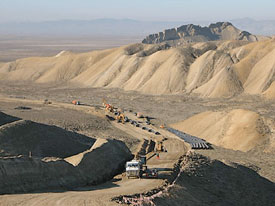 |
Fig. 1. Pipe sections were laid along a section of the BTC right-of-way in Gobustan, Azerbaijan.
|
|
For now, the pipeline routes seem to be accepted by most countries. Russia has accepted construction of the BTC pipeline, and there are questions as to whether Iran would have transported Azerbaijan's oil through its territory. The route to ship oil through Iran would have been the cheapest, by far.
AZERBAIJAN
Of the estimated 3 million bopd to be produced from the Caspian by 2010, about one third would come from Azerbaijan.3,4 In 2002, Azerbaijan's oil production was 22% of total Caspian Sea output. If Azerbaijan's political situation continues to favor investment by foreign companies, and the geopolitical state of affairs can be resolved between the Caspian Sea's surrounding countries, then Azerbaijan's potential is even greater.
Azerbaijan has been an oil-producing province for a long time. According to some historians, it is supposed to be the site of the first purpose-drilled oil well in the world, drilled in 1848 – 1849, just south of Baku. Oil field exploitation began in the 1870s and continued until World War I. Azerbaijan became an independent republic after the demise of the Russian Empire in 1918 and was recognized as an independent country by Western nations in January 1920. Three months following this recognition (April 1920), the Russian Red Army took over this country, and it became part of the emerging Soviet Union (USSR).
Azerbaijan's production peaked at over 500,000 bopd during World War II, but it has yet to reach that production level again. It was a strategic, potential oil supply that Nazi Germany targeted in World War II but was never able to acquire. Had the Germans achieved this, the balance of the war could have shifted from the Allies to the Germans. Azerbaijan stayed as a member of the USSR for most of the Twentieth Century, until it became an independent country for the second time in history, in August 1991.
Azerbaijan's current promise of hydrocarbons lies in the Caspian Sea, to the country's east. In 2002, Azerbaijan's oil production was a little over 300,000 bpd.5 Given the current development projects in the Caspian Sea, the country should surpass its historical oil production peak in the near future.
From 1987 through 1995, Azerbaijan's oil production declined at a rate of 5.4%.5 Thanks to the “Contract of the Century,” this decline has ended. The contract, signed in 1994 between Azerbaijan and 11 international companies, involves the development of Caspian Sea reserves in the Azeri, Chirag and Gunashli (ACG) fields. Through this contract, Azerbaijan International Oil Co. (AIOC) was created. Members include state oil company SOCAR and 11 international firms.
After the contract was signed, oil production stabilized between 1995 and 1997. It has been increasing at an average 10.2% since 1997.5 If this rate (considered conservative, given the number of new projects slated) continues, Azerbaijan will surpass 500,000 bopd in 2007. First oil from the BP-operated ACG fields was in 1997, and this has been the main reason for the country's production increase. In early 2004, the area produced 130,000 bopd. It is expected to produce 400,000 bopd by 2005 and peak at 1 million bopd.6 Production, consumption and exports of Azerbaijani oil since 1985 are shown in Fig. 2.5
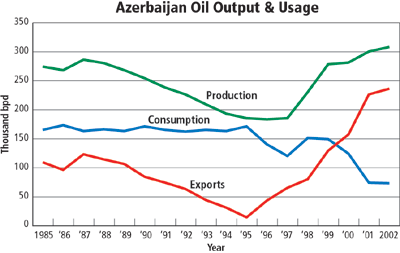 |
Fig. 2. After bottoming out in the mid-1990s, Azerbaijan's oil production has gained steadily, while consumption has decreased, leaving greater volumes for export.
|
|
The Contract of the Century paved the way for many more production sharing agreements. So far, these pacts have committed a total investment of more than $60 billion in Azerbaijan's oil development.7 The prize that the international operators are chasing is proven oil reserves of between 7 billion bbl and 12.5 billion bbl, with a potential for an additional 32 billion bbl. Proven natural gas reserves also total 30 Tcf. Potential exists for an additional 35 Tcf.4 Although Azerbaijan has fewer reserves than Kazakhstan, the country's ability to cooperate with, and openness to, international investment has enticed such companies as BP, ExxonMobil, Statoil and others to invest heavily.
Azerbaijan's economy. Azerbaijan's future economy depends greatly on the proper utilization of hydrocarbon revenues. The country is low-income, with a per capita income in 2002 of only $710.8 Nonetheless, Azerbaijan's income has quadrupled since 1995, much of it due to the Contract of the Century. This increase compares to a GDP that decreased by 18.5% in 1995.8 The projected GDP growth in 2004 is 9.1%.9 The economy is growing at a fast pace.
With 64% of the population below the poverty line, the country is in a transitional economy. While the oil sector accounted for 90% of Azerbaijan's exports, it generated only 1% of all jobs.10 The projected $60 billion of international investment in oilfield development should add plenty of employment.
One sign that the government is attempting to diversify its economy and keep it growing far into the future is the creation of the State Oil Fund of the Republic of Azerbaijan (SOFAZ). SOFAZ was established in 1999 and created to put aside some of the country's oil-related revenue and manage it for future use.11
Becoming a major player. Azerbaijan faces many of the problems common to other Caspian Sea nations in its quest to become a major player in hydrocarbon exports.
While oil companies have lined up to take part in Azerbaijan's hydrocarbon development, issues still stand in the way of delivering commercially viable hydrocarbons. Azerbaijan sits on the western coast of the Caspian Sea, and its neighbors include Iran to the south, Georgia and Armenia to the west, and Russia to the north.
Transportation of Azerbaijan's abundant reserves is a major problem. There is not enough pipeline capacity to export the amount of oil that can be produced. Also, as Azerbaijan in the past has been a gas importer, there are no export pipelines available for its potential gas output. New lines will be necessary for fields that will be coming onstream, such as Shah Deniz. As one of the largest gas/condensate fields in the world, it will begin exporting gas in 2006.
Pipelines are the only feasible way to transport oil and gas out of the Caspian Sea, where most of Azerbaijan's reserves are located. With the Caspian landlocked, there is no possibility of using tankers to ship oil to other locations. Therefore, new pipelines are being built, and more are contemplated for the future. With some of the future pipelines still under consideration, Azerbaijan's location and Western geopolitics are playing an important role in the location of these lines.
With current and planned pipelines, Azerbaijan seems to be in reasonable shape regarding future capacity. Currently, Azerbaijan has two export pipelines. The “northern route” is the 100,000-bpd Baku-Novorossiysk pipeline, which sends oil to the Russian Black Sea coast. It began exporting oil in 1997. Under present plans, this pipeline's capacity will be upgraded to 300,000 bopd.2 The “western route” is the 115,000-bpd Baku-Supsa pipeline, which sends oil to Georgia's Black Sea coast. It began exporting oil in 1999.
Under construction since early 2003, the Baku-Tbilisi-Ceyhan (BTC) pipeline is expected to increase export capacity five-fold with its 1-million-bopd capacity. This new pipeline is scheduled to begin exporting oil in early 2005, and it will cover 1,040 mi through Georgia and Turkey, bypassing the progressively busier Bosporus Straits. Another new pipeline will be built parallel to this, to transport natural gas. It will be called the Baku-Tbilisi-Erzurum pipeline and will handle 233 Bcf of natural gas per year. It should be finished in 2006, in time for Shah Deniz's first contracted gas exports. The locations of the existing, under construction and/or proposed pipelines in the region are shown in Fig. 3.12
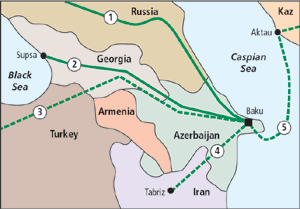 |
Fig. 3. Caspian region pipelines, existing and proposed, include 1) The Northern Pipeline; 2) The Western Pipeline; 3) The BTC Pipeline; 4) The Baku-Iran Pipeline; and 5) The Trans-Caspian Pipeline.
|
|
Azerbaijan fully intends to become a major player and has tried to alleviate the region's geopolitical tensions. The one conflict that needs to be resolved is a dispute with Turkmenistan and Iran with regard to overlapping fields. Hopefully, this can be resolved peacefully.
One troubling event to international observers is the recent election of Ilham Aliyev as president in October 2003. He is the previous president's son, and he won in a landslide election described as “falling short of international standards.”
GEORGIA
Georgia is strategically located between the Black Sea and the oil-rich Caspian, and it has been a focus of potential conflict between the US, other Western nations and Russia, Fig. 4.13,14 Although Georgia has limited hydrocarbon resources, it controls much of the Caucasus Mountains and the potential pipeline routes through them. Thus, it is emerging as a key transit country.15,16,17
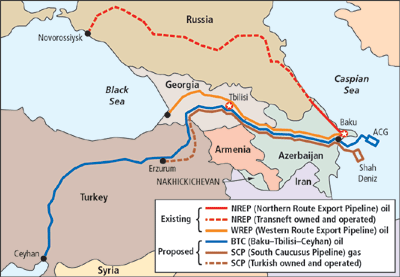 |
Fig. 4. Georgia's strategic position within the region will allow it to profit from pipelines through its territory, but it also is a source of geopolitical bickering.
|
|
Georgia was absorbed into the Russian Empire in the 19th century. Independent for three years (1918 – 1921) following the Russian revolution, it was forcibly incorporated into the USSR until the Soviet Union's collapse in 1991. Ethnic separation in Abkhazia18 and South Ossetia, plus poor governance and Russian military bases, deny the government effective control over all of the state's internationally recognized territory. There has been a discernible effort by Georgia to approach the West, often at the consternation and mistrust of Russia.19
Widespread corruption in Georgia led to the storming of parliament in December 2003. Mikhail Saakashvili, a 35-year-old American-trained lawyer, organized and headed up the nearly month-long street demonstrations that led to President Eduard Shevardnadze's resignation. Georgian parliamentary and presidential elections were planned for January 2004.
Georgian economy. The dissolution of the USSR precipitated a significant fall in the overall size of Georgia's economy. This was made worse by hyperinflation, and accompanied by an associated fall in standards of living. The Georgian economy reached a record low in 1992 – 1994, although the country still enjoys a considerably higher per-capita GDP than Azerbaijan, at about $5,500. However, recent statistics suggest that more than half of Georgians are unemployed.
The country risks financial collapse without immediate Western aid. The economy is in worse shape than is publicly known. Georgia's interim leaders are seeking help, not only in financing the new elections, but even more important, in rebuilding Georgia's dilapidated public infrastructure.
Georgia vs. Russia. Russian President Vladimir Putin has expressed readiness for radical improvement of Russian-Georgian relations. Yet Georgia accuses Russia of being “barbaric” at the same time that it wants to improve relations. This is important, as the Georgian economy and energy needs depend so much on Russia.
One of the main issues of conflict with Russia is the Georgian army's inability to deal with Chechen rebels, who have been embroiled in militant activities in Russia. The would-be, breakaway Russian republic of Chechnya is crucial for control of the rich oil supplies of the Caucuses. Georgia and Russia conflicted recently over the “Pankisi Gorge” on the border with Chechnya, after Tbilisi accused Moscow of aggression. Russia strongly denies the accusations and in turn, claims that Georgia has failed to act against Chechen rebels, who Moscow believes use the gorge as a shelter. Russian politicians are also angry at US support of the Georgian version of events.20, 21
Russia is very much interested in Georgia's political stability, because an unstable Georgia can mean hundreds of thousands of refugees crossing into Russian territory. Also, Georgia's territory could be taken by international terrorists, who might launch attacks on Russia from that site. Russia has long considered Georgia part of its sphere of influence and is uneasy seeing US troops deployed there.
Georgia and the US. The relationship between Georgia and the US is growing stronger. The American influence and its role in the recent political drama is the most vivid example. Shortly after Eduard Shevardnadze resigned as president, his US-backed successors joined with US Secretary of State Colin Powell to publicly criticize Russia, and demand that it remove its troops from Georgia and another former Soviet republic, Moldova. US Secretary of Defense Donald Rumsfeld's visit in December 2003 was an additional show of US support. In return, Georgia has provided coalition troops in Iraq.
Energy in Georgia. Shortages abound in the energy industry, which is the most corrupt sector in Georgia and has been for 10 years. Since 1991, Georgia has faced an acute energy crisis. Russia and Turkmenistan (main exporters to Georgia) dramatically increased the prices of their energy supplies, and this caused a severe decline in Georgia's economy. The situation worsened with destruction of a stretch of the gas pipeline between southern Russia and Georgia in 1992. It was exacerbated in 1994 by Georgia's inability to pay for gas imports. Currently, Georgia imports oil from Iran and continues to import electricity from Russia and Turkey.
Georgia is important, because it is positioned to become an important corridor for oil and gas transportation between the Caspian Sea and Western markets. At least four pipelines are either operational or planned/ under construction:15,16,17
- Baku-Supsa Oil Pipeline. In 1999, the Baku-Supsa early oil pipeline was inaugurated at the Supsa terminal on the Black Sea coast, beginning the flow of Azeri oil across the Caucasus to market. The pipeline's 115,000-bopd capacity can be doubled with additional pipeline upgrades and facilities. The pipeline is owned by the AIOC consortium of Western energy companies.
- Kashuri-Batumi Pipeline. ChevronTexaco has been granted rights to utilize an existing, yet aging, pipeline from Kashuri (near Tbilisi) to Batumi (on the Black Sea coast).
- Main Export Pipeline, the Baku-Tbilisi-Ceyhan (BTC) pipeline. Georgia is set to be the transit country for the Baku-Ceyhan main export pipeline. When completed, the project should deliver up to 1.0 million bopd at its peak. This project is of regional significance, as it represents the first direct transportation link between the Caspian and the Mediterranean, thus avoiding the Bosporus Straits.
The BTC pipeline should be completed by 2005. The Georgian section of the pipeline is 248 km (154 mi) long and will generate substantial revenues for Georgia. Although BP owns 38% of the venture and ENI recently took a 5% share, all nine members must make final commitments to the 1,730-km (1,075 mi) project. Construction of the Georgian section began in April 2003.
- Trans-Caspian Gas Pipeline Project: Georgia is set to be one of the transit countries in the Trans-Caspian Pipeline (TCP) project between Turkmenistan and Turkey. The line's capacity is expected to be 1.0 Tcf of gas per year, with about half consumed in Turkey and the remainder re-exported to Europe.
KAZAKHSTAN
Situated in central Asia, on the edge of the European and Asian continents, is the world's largest landlocked country, Kazakhstan. It is four times the size of Texas and holds the largest recoverable crude oil reserves in the Caspian Sea region. Kazakhstan produces roughly 1.0 million bopd, or about two-thirds of the region's total production.5
It is easy to see why, as foreign investment pours into the country's oil and gas sectors, that Kazakhstan is beginning to realize its enormous production potential. Such companies as ChevronTexaco (the first major Western oil company to enter the region in 1993) have made Kazakhstan their place to develop some of the world's largest oil fields.22
In 2003, ChevronTexaco announced plans to invest $4 billion in Kazakhstan over the subsequent four to five years.23 The funds will further develop the company's three regional projects, TengizChevroil, the Caspian Pipeline Consortium and the Karachaganak Integrated Organization.24
Russia's LUKoil also made a similar announcement last December about investing $3 billion in the Dostyk Block. Comprising two fields, the block's reserves are estimated at “several hundreds of millions of tons of oil.”24 With sufficient export options in the near future, and with much infrastructure presently under development, these announcements, alone, would make Kazakhstan a major producer and exporter over the next decade.
Kazakhstan consists of three ethnic groups; it is primarily Kazakh, at almost half of the population, followed by Russian and Ukrainian. The population is split almost evenly between the Muslim and Russian Orthodox religions. Although Kazakh is the official language, Russian is also spoken rather widely, primarily in business.
After the USSR's demise, the newly created, independent Republic of Kazakhstan opened its doors to foreign business in 1991. Its economic growth in recent years has been driven not only by petroleum, but also by changes in its governing system. Its President, Nursultan Nazarbaev, a former leader of the Soviet Kazakhstan Communist Party since 1977, became the new republic's first interim president. He was then elected president in the country's first national elections in December 1991. Due to a 1995 referendum that extended his term, President Nazarbaev was re-elected in 1999. He will be up for re-election again in 2006.25
Kazakhstan's economy. Kazakhstan holds Central Asia's largest economy. Because of its booming energy sector, economic reforms and foreign investment, Kazakhstan's GDP grew 9.5% in 2002 to an estimated $120 billion. This resulted in an estimated per-capita GDP of about $7,200.25 This marked the first time that significant economic growth was observed over three consecutive years since Kazakhstan's independence in 1991.
More than 55% of the country's revenue is dependent on oil and gas. The country's other exports include zinc, copper, titanium, gold, silver, machinery, coal and meat. Kazakhstan's industrial sector depends heavily on the recovery and processing of these natural resources, as well as on its growing machine fabrication sector that focuses on construction equipment, tractors, agricultural machinery and armaments.
Kazakhstan's economy experienced a decline in the mid-1990s, as a direct result of the breakup of the USSR and the fall in demand for Kazakhstan's traditional heavy industry. The steepest annual decline was observed in 1994.
Shortly following the decline, the pace of the governmental program of economic reform and privatization quickened, resulting in a significant shift of assets away from the state into the private sector. The 2001 opening of the Caspian Consortium pipeline, from Tengiz field to the Black Sea, has significantly raised export capacity while allowing for economic growth. However, despite the large petroleum sector, Kazakhstan has adopted an industrial policy designed to diversify the economy away from over-dependence on oil and gas by developing light industry.25
Kazakhstan's energy sources. Kazakhstan controls a large portion of Caspian coastline and possesses this freshwater lake's largest known oil field (Kashagan). Accordingly, the country has absorbed $20 billion of foreign petroleum investment since the fall of communism.26
Combined onshore and offshore proven reserves are estimated to be between 9.0 billion bbl and 18 billion bbl. This is comparable to the reserves of Algeria or Qatar.4 Kazakhstan's 2002 oil production was just shy of 1 million bpd, of which about 130,000 bpd were consumed inside the country.5 Kazakhstan's historical oil production/ consumption trend is charted in Fig. 5. Although still a relatively minor oil exporter, Kazakhstan is on its way to becoming a significant player in the next 10 years. The country's proven natural gas reserves total 65 Tcf, mostly in western Kazakhstan's Karachaganak field.4 These gas reserves rank roughly 20th in the world. However, despite the large gas reserves, Kazakhstan has only recently begun to produce more than it consumes, with current output around 0.4 Tcf (1.1 Bcfd).5
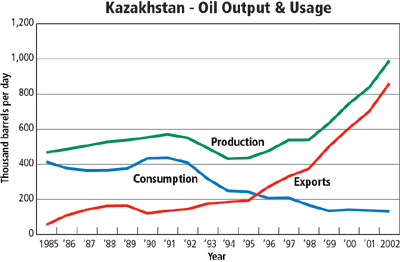 |
Fig. 5. Kazakhstan's oil production has doubled over the last 10 years, while consumption has declined, leaving plenty of room for exports.
|
|
Kazakhstan's oil production grew an average 16% annually between 1999 and 2002, and output has nearly doubled since its independence in 1991. In June 2003, the government announced a new offshore development program. Through this program, new offshore blocks will be auctioned off, starting as early as 2004. Kazakh officials hope that this effort will boost the country's production to approximately 2.4 million bopd by 2010 and 3.6 million bopd by 2015.27 This output is expected to come from the country's three largest fields – Tengiz, Karachaganak and Kashagan.
Located onshore, just inland from the shores of the Caspian, Tengiz is considered to be the world's deepest super-giant oil field.22 According to operator ChevronTexaco, its discovery in 1979 generated estimated reserves of 6 billion bbl to 9 billion bbl. The field has been developed by the Tengizchevroil (TCO) joint venture between ChevronTexaco, Exxon-Mobil, Kazmunaigaz and Luk-Arco. Tengiz produces about 285,000 bopd, or approximately one-third of national production. A new agreement between Kazakhstan and TCO has initiated a $3-billion expansion project that will increase the field's capacity to 450,000 bopd by 2006.27
In northern Kazakhstan is Karachaganak onshore oil and gas/condensate field. It holds reserves comprising more than 2.3 billion bbl of oil and 16 Tcf of gas. It has a projected 40-year life span at the current output rate of about 100,000 bopd, with plans for expansion.28
Kashagan field, although still being appraised, is expected to produce its first oil in 2005, at an initial rate of 100,000 bopd.27 As stated earlier, the field is expected to be the second, most prolific deposit in the world, following Saudi Arabia's Ghawar Field.29 Future production potential is very significant, but current difficulties that need to be resolved include Caspian ownership, export routes and infrastructure.
Petroleum transportation. Kazakh oil is exported in three general directions – westward, northward and southward. Oil heading west is transported via the Caspian Pipeline Consortium. Additional excess capacity is shipped on a barge through the Caspian Sea to Azerbaijan.
Oil transported north to Russia is shipped via a pipeline system or carried on the existing rail network. Finally, the oil shipped south is typically swapped with Iran. Because of its geographical location and access to ports on both the Black Sea and Persian Gulf, Kazakhstan is able to trade some of its oil on the world market. Because of the expected rapid growth of Kazakhstan's exports, many efforts are underway to expand infrastructure to allow a higher export capacity.
One such project, which adds extra export capabilities and connects the area's oil deposits with Russia's Black Sea ports, is the Caspian Pipeline Consortium (CPC), overseen by the Russian, Kazakh and Omani governments in conjunction with various international companies. The pipeline opened in November 2001 at an initial capacity of 560,000 bopd.27 CPC recently announced plans to more than double its annual capacity to 67 million t, or approximately 1.3 million bopd.30 Prior to completion of the CPC, nearly all of Kazakhstan's oil exports were distributed though the Atyrau-Samara line, a northbound pipeline linking up to the Russian system.
Many other pipelines have been reported under active or theoretical consideration. They include a highly ambitious, controversial pipeline heading eastward to what will be an ever more oil-demanding China, as well as a subsea pipeline across the Caspian Sea connecting to the Baku-Tbilisi-Ceyhan project.
Several natural gas pipeline projects are also under consideration or already in development. Although they are in their infancy, these lines have the potential to open up markets for Kazakh natural gas. Further, Kazakhstan could play an important regional role, given that it serves as a gas transit center for Turkmen and Uzbek gas piped to Russia and beyond, Fig. 6.
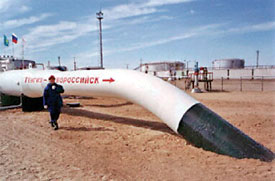 |
Fig. 6. Via the Kazakhstani pipeline, Kazakhstan could become a focal point for trans-shipment of gas from Turkmenistan and Uzbekistan.
|
|
Kazakhstan – China connection. On its east, Kazakhstan borders China for approximately 1,000 mi.25 As the Chinese demand for oil and gas increases, China has begun exploring options with its neighbor by making major investments within the Kazakh oil and gas sector. China's CNPC recently joined the Kashagan field consortium, and the firm in 1997 bought 60% of Kazakh oil company Aktobemunaigaz.31,32 A pipeline is essential to export oil from Kazakhstan into China. Feasibility studies for route options are underway and should be completed by the fall of 2004.33
Last October, Kazakhstan announced that work would begin in 2004 on this project, one of the world's longest pipelines.34 Building the pipeline, however, will be a formidable task, with many physical and political problems looming. Many observers have warned that the Kazakhstan-China route could be very problematic, due to numerous obstacles associated with its 3,200-km length. One of the most important project issues is that China has asked Kazakhstan to deliver 50 million t of oil annually via this pipeline. This is more than Kazakhstan's current, total production of 47 million t. The likelihood of Kazakhstan selling all of its oil to one customer is zero, given the country's ambitions for a world role. Initial hopes from several years ago to complete the entire Kazakhstan-China pipeline by 2005 are now unattainable. 
LITERATURE CITED
1 “Caspian sea oil and gas exploration update and hearing summary,” hearing testimony, 106th US Congress, May 16, 2000.
2 BTC website, BP plc, www.caspiandevelop-mentandexport.com.
3 Koerner, B., “What if the Caspian region was a major oil supplier,” Worldlink magazine, World Economic Forum, January/ February 2002.
4 US Energy Information Administration (EIA), Caspian Sea Region: Key Oil and Gas Statistics, August 2003.
5 BP Statistical Review of World Energy, June 2003.
6 BTC website, BP plc, www.caspiandevelop-mentandexport.com, Azeri-Chirag-Gunashli fact sheet.
7 The World Factbook, Central Intelligence Agency, December 2003.
8 Azerbaijan fact sheet, Development Data Group, World Bank.
9 Azerbaijan Country Analysis Brief, Energy Information Administration, June 2003.
10 United Nations Resident Coordinator's Annual Report for Azerbaijan, 2002.
11 “About the fund,” State Oil Fund of Azerbaijan website, http://www.oilfund.az.
12 “An energy overview of the Republic of Azerbaijan,” US Dept. of Energy, www.fe.doe.gov.
13 “Georgia's rose revolution: A made-in-America coup,” www.khilafah.com, December 7, 2003.
14 Caspian development map and pipelines, BTC website, BP plc, www.caspiandevelopment-andexport.com.
15 “Georgia: Transit of Caspian Sea region oil and gas,” US Energy Information Administration, April 2001.
16 “Pipeline projects in Georgia,” US International Trade Administration, www.ita.doc.gov.
17 “Oil & gas production, Georgia, 2000,” US Energy Information Administration, www.eia.doe.gov.
18 The Republic of Abkhazia, www.abkhazia.org.
19 Central Intelligence Agency, Ibid.
20 Political news, Georgia, www.eurasianet.org.
21 Delisio, C., “A quiet battle in the Caucasus: Georgia between Russia and NATO, www.antiwar.com.
22 Kazakhstan Fact Sheet, Eurasia Operations, ChevronTexaco.
23 “CheveronTexaco to invest $4 Billion in Kazakhstan in next 4 – 5 years,” TASS Energy Service News Agency, November 26, 2003.
24 “LUKoil to develop Dostyk Block in Kazakhstan,” NOVECON: Russian Energy Digest, December 8, 2003.
25 Central Intelligence Agency, Ibid.
26 “Kazakhstan seeks Caspian oil cartel,” Reuters, Moscow, December 28, 2003.
27 Kazakhstan Country Analysis Brief, US EIA, July 2003.
28 “Kazakhstan: Major oil and natural gas projects,” US EIA, July 2002.
29 “Kazakh oil finds Confirm Caspian as world class,” Energy Compass, November 25, 2003.
30 “Caspian pipeline consortium to increase oil pipeline capacity,” Kazakhstan-Gateway, RBC, November 20, 2003.
31 “Kazakhstan: China seeks oil investment with an eye on pipeline,” Radio Free Europe, March 2003.
32 “What's at stake for whom – China,” World Press Review Online, www.worldpress.org.
33 “Kazakhstan-China gas pipeline study to be ready in 2004,” Interfax, October 2003.
33 “Work on mammoth Kazakhstan-China oil pipeline to start next year,” Agence Grance-Presse, October 10, 2003.
THE AUTHORS
|
 |
Randall Collum Jr. graduated from the University of Houston with a BS degree in chemical engineering in 2001 and is enrolled in the masters of petroleum engineering program at the same university. He has almost three years of experience with a major petroleum company and has had roles as both a production and reservoir engineer in the Gulf of Mexico Continental Shelf.
|
 |
Adrian J. Gregorek received a BS degree in mechanical engineering with honors from Texas A&M University in 2000. He has been employed by a major petroleum company as both a facilities and subsea engineer, within the firm's E&P operations. His experience ranges from operations to project development and execution within Gulf of Mexico deepwater blocks. His current focus is on subsea work. He is working on his masters in petroleum engineering degree from the University of Houston.
|
 |
Amit Sondhi has just completed his masters degree in petroleum engineering at the University of Houston. He holds a BS degree in electronics engineering from North Maharashtra University in India.
|
 |
Michael J. Economides is a professor at the Cullen College of Engineering, University of Houston, and the chief technology officer of the Texas Energy Center. Previously, he was the Samuel R. Noble professor of petroleum engineering at Texas A&M University and served as chief scientist of the Global Petroleum Research Institute (GPRI). Before that, Dr. Economides worked in a variety of senior technical and managerial positions with a major petroleum services company. His publications include authoring or co-authoring 11 professional textbooks and books, including The Color Of Oil, and almost 200 journal papers and articles. He does a wide range of industrial consulting, including major retainers by national oil companies at the country level and by Fortune 500 companies.
|
|












